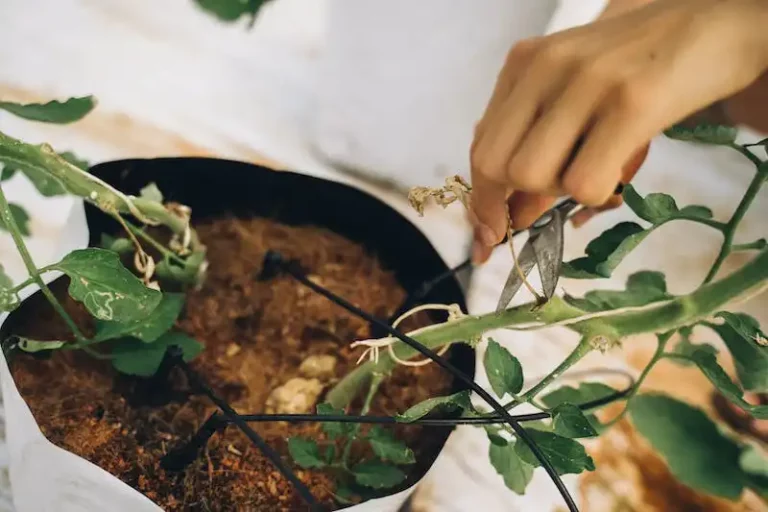If you’re a fan of indoor plants, it’s likely that you’ve come across spider plants. They’re a favorite among plant lovers for their beautiful cascading foliage and easy care requirements. One of the best things about spider plants is that they can easily be propagated, allowing you to grow more of them and share with your friends!
Propagation is the process of creating new plants from existing ones, and spider plants are great for this because they produce plenty of “babies” or spiderettes. These spiderettes can be rooted and grown into full-grown plants, making it a fairly easy and rewarding project.
To start the propagation process, the first thing you need to do is locate the spiderettes on the parent plant. These spiderettes are small plants that have formed on long stems. Once you’ve found the spiderettes, all you need to do is gently remove them from the parent plant and place them in a small container with water.
It’s important to make sure that the spiderettes are adequately watered during this process. You can do this by covering the container with a plastic wrap or a plastic bag to create a humid environment. Keep the container in a warm place and make sure to regularly check the water level to ensure that it stays above the spiderettes’ base.
After about a week or two, you should start seeing roots forming on the spiderettes. Once the roots have grown to about an inch long, you can transplant the spiderettes into individual pots with well-draining soil. Make sure to keep the soil consistently moist and place the pots in a bright spot where they can receive indirect sunlight.
Spider plants are known to be very hardy, so they’re forgiving when it comes to propagating. Even if you’re unsure about certain steps or wondering if you’re doing it right, don’t worry! Spider plants are fairly easy to propagate, and with a little bit of patience, you’ll be rewarded with more spiderettes and full-grown plants in no time.
Remember, propagating spider plants is a great way to bring more greenery into your home and share the joy of plant care with others. So go ahead and give it a try! You’ll be amazed at how quickly and easily you can grow your collection of spider plants.
Spider Plant Propagation In 5 Easy Steps
Spider plants, scientifically known as Chlorophytum comosum, are popular houseplants due to their attractive foliage and easy propagation. If you have a spider plant at home and want to expand your collection without spending extra money, propagating spider plants is a great option. Here are 5 easy steps to propagate spider plants:
Step 1: Identify the Spiderettes
Spider plants produce long stems with baby plants, called spiderettes, at the end. These spiderettes can be easily identified by their miniature versions of the parent plant’s foliage. When the spiderettes have developed roots, it is the perfect time to propagate.
Step 2: Prepare a Clear Plastic Container
Instead of dividing the parent plant, spider plants can be propagated by taking cuttings from the spiderettes. To do this, prepare a clear plastic container with a damp moss surface. This will help the cuttings develop roots faster and more effectively.
Step 3: Take Cuttings
Using a sterile pair of scissors or pruning shears, cut the spiderettes from the parent plant, making sure to leave a small stolon attached. This stolon is essential for the new plant to develop roots.
Step 4: Plant the Cuttings
Place the cuttings onto the damp moss surface in the plastic container. Make sure that the stolons are in contact with the moss. This will help the cuttings absorb water and nutrients more easily.
Step 5: Provide Optimal Growing Conditions
Spider plants are relatively easy to care for and will usually grow well in most conditions. However, to ensure successful propagation, provide optimal growing conditions such as bright indirect light, regular watering, and a well-draining potting mix. Keep the container in a warm spot, and mist the foliage with water to maintain humidity.
By following these 5 easy steps, you can propagate spider plants without much effort. It is a simple and cost-effective way to fill your home with beautiful spider plants. If you have any more questions about spider plant propagation, check out our FAQs section below.
How To Propagate Spider Plants
If you have a spider plant and you want to expand your collection or share them with friends, propagating spider plants is a great option. Spider plants are known for their ability to produce plenty of plantlets, also known as spiderettes, which can be easily propagated to create new plants.
The first thing you need to do is locate the mother plant, which is the mature spider plant that is producing the spiderettes. Spider plants usually produce spiderettes when they are happy and healthy, so make sure your mother plant is in a good environment.
To propagate a spider plant, you will need a few tools: a pair of clean scissors, a small pot filled with potting soil, and a chopstick or a similar tool for planting. It’s also a good idea to have a container filled with water nearby.
Here are the steps to propagate spider plants:
- Identify a healthy spiderette that is attached to the mother plant.
- Using the scissors, carefully cut the spiderette off the mother plant, making sure to leave a little bit of the stolon (the stem that attaches the spiderette to the mother plant).
- Fill the small pot with potting soil and make a small hole in the center using the chopstick.
- Place the spiderette in the hole and gently press the soil around it to secure it in place.
- If you prefer, you can also place the spiderette in a container filled with water and let it develop roots before planting it in soil.
- Keep the soil or water consistently moist, but not too wet.
- Place the pot or container in a warm and bright location, but avoid direct sunlight.
- After a week or two, the spiderette should start growing roots and can be considered a new plantlet.
Spider plants are relatively easy to propagate, and they can also be propagated through other methods, such as planting the plantlet directly into the soil or placing it in a plastic bag with a moist paper towel. However, the steps outlined above are a popular and effective way of propagating spider plants.
One thing to keep in mind when propagating spider plants is that not all spiderettes will survive. Some may fail to root or may not develop into healthy plants. It’s also worth noting that spiderettes that have been removed from the mother plant and placed in soil or water may take longer to grow compared to spiderettes that are still attached to the mother plant. So be patient and give your spiderettes the time they need to grow.
Propagation is a great way to share the joy of spider plants with others or to expand your own spider plant collection. Whether you prefer to propagate spider plants through soil or water, the end result is a new plant that you can enjoy and possibly gift to others.
So go ahead and give spider plant propagation a try – you might just discover a new passion for growing and propagating these beautiful houseplants!
What Are Spider Plant Babies
If you’ve ever owned a spider plant (Chlorophytum comosum), you may have noticed little plantlets forming on long, arching stems. These plantlets, often referred to as “spider plant babies,” are small, miniature versions of the parent plant. They seem to pop up everywhere and can be easily propagated to create new plants.
Spider plant babies are best grown in a warm environment with bright, indirect light. They can be found on the same stems as the flowers, which is why they are also known as plantlets. The plant produces these plantlets as a way to reproduce and continue its growth.
When the spider plant babies are ready for propagation, they will begin to grow their own little root system. At this stage, you can remove them from the parent plant and place them in water or soil. It’s recommended to wait until the plantlets are about 2-3 inches long before removing them to ensure they have strong roots.
To propagate spider plant babies, simply cut them off the stolon (the long, arching stem) using a clean pair of scissors or garden shears. Place the plantlets in water and wait for roots to form. You can also plant them directly into a small pot with well-draining soil. If you choose to put them in water, make sure to change the water every week or so to keep it fresh.
If you prefer, you can also propagate spider plant babies by placing them directly onto moist soil. Gently press the plantlet onto the soil surface, making sure the roots are in contact with the soil. This method is especially useful if the plantlets already have well-developed roots.
Spider plant babies can be easily transplanted once they have developed a good root system. Carefully remove them from the water or soil they were initially propagated in, and plant them in a larger pot or in the garden. Make sure to provide them with a protected and warm environment to help them adjust to the new growing conditions.
Spider plant babies are a popular choice for plant lovers as they are relatively easy to care for and propagate. They can be a great addition to your indoor or outdoor garden, adding a touch of greenery with their cascading leaves. So, if you’re looking to expand your spider plant collection or share them with friends, why not try propagating some spider plant babies!
When To Propagate Spider Plants
Spider plants are known for their ability to propagate easily, making them a popular choice for plant enthusiasts. If you’re looking to expand your collection or share spider plant babies with others, knowing when to propagate can help ensure the best chances of success.
Spider plant propagation is best done during the spring and summer months when the plant is actively growing. This is when the parent plant shows signs of new growth, such as producing baby spider plants.
When propagating spider plants, it’s important to choose healthy parent plants. Look for spider plants that have well-developed root systems and no signs of disease or damage. A sterile potting mix or moss should be used for propagation, as it provides a clean and nutrient-rich environment for the baby spider plants to grow.
To propagate spider plants, start by removing the baby spider plants from the parent plant. Gently separate the baby spider plants from the base of the parent plant using a clean and sharp tool, such as scissors or a small brush.
Once the baby spider plants are removed, they can be placed in a sterile potting mix or moss. Make sure to water the soil thoroughly and keep it evenly moist. It’s also important to provide the baby spider plants with bright, indirect light to promote healthy growth.
After a week or two, the baby spider plants should develop roots and can be transplanted into their own individual pots. Remember to use fresh potting mix and water the newly transplanted plants well.
Spider plants, especially variegated varieties, can sometimes produce flowers. While the flowers can be attractive, it’s important to remove them during propagation to allow the plants to focus their energy on growing roots and new foliage.
In summary, the best time to propagate spider plants is during the spring and summer months when the parent plant is actively growing. Choose healthy parent plants, remove the baby spider plants, and place them in a sterile potting mix or moss. Keep the soil moist, provide bright but indirect light, and remove any flowers to promote healthy root and foliage growth.




